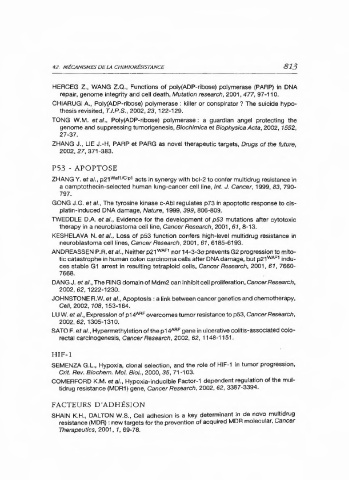Page 855 - Traité de chimie thérapeutique 6 Médicaments antitumoraux
P. 855
42 MECANISMES DE LA CHIMIORÉSISTANCE 813
HERCEG Z., WANG Z.Q., Functions of poly(ADP-ribose) polymerase (PARP) in DNA
repair, genome integrity and cell death, Mutation research, 2001, 477, 97-110.
CHIARUGI A., Poly(ADP-ribose) polymerase: killer or conspirator? The suicide hypo-
thesis revisited, T./.P.S., 2002, 23, 122-129.
TONG W.M. et al., Poly(ADP-ribose) polymerase : a guardian angel protecting the
genome and suppressing tumorigenesis, Biochimica et Biophysica Acta, 2002, 1552,
27-37.
ZHANG J., LIE J.-H, PARP et PARG as novel therapeutic targets, Drugs of the future,
2002, 27, 371-383.
P53- APOPTOSE
1
ZHANG Y. et al., p21Wan/Ci acts in synergy with bcl-2 to confer multidrug resistance in
a camptothecin-selected human Jung-cancer cell line, /nt. J. Cancer, 1999, 83, 790-
797.
GONG J.G. et al., The tyrosine kinase c-Abl regulates p73 in apoptotic response to cis-
platin-induced DNA damage, Nature, 1999, 399, 806-809.
TWEDDLE D.A. et a/., Evidence for the development of p53 mutations after cytotoxic
therapy in a neuroblastoma cell line, Cancer Research, 2001, 61, 8-13.
KESHELAVA N. et a/., Loss of p53 function confers high-level multidrug resistance in
neuroblastoma cell lines, Cancer Research, 2001, 61, 6185-6193.
1
ANDREASSEN P.R. et al., Neither p21WAF +or 14-3-3o prevents G2 progression to mito-
tic catastrophe in human colon carcinoma cells after DNA damage, but p2{WAF1 indu-
ces stable G1 arrest in resulting tetraploid cells, Cancer Research, 2001, 61, 7660-
7668.
DANG J. et a/., The RING domain of Mdm2 can inhibit cell proliferation, CancerResearch,
2002, 62, 1222-1230.
JOHNSTONE R.W. et al., Apoptosis : a link between cancer genetics and chemotherapy,
Ce//, 2002, 108, 153-164.
LU W. et al., Expression of p14F overcomes tumor resistance to p53, CancerResearch,
2002, 62, 1305-1310.
SATO F. et al., Hypermethylation of the p14f gene in ulcerative colitis-associated colo-
rectal carcinogenesis, Cancer Research, 2002, 62, 1148-1151.
HIF-1
SEMENZA G.L., Hypoxia, clonai selection, and the role of HIF-1 in tumor progression,
Crit. Re. Biochem. Mol. Biol., 2000, 35, 71-103.
COMERFORD K.M. et al., Hypoxia-inducible Factor-1 dependent regulation of the mul-
tidrug resistance (MDR1) gene, Cancer Research, 2002, 62, 3387-3394.
FACTEURS D'ADHÉSION
SHAIN K.H., DALTON W.S., Cell adhesion is a key determinant in de novo multidrug
resistance (MDR) : new targets for the prevention of acquired MDR molecular, Cancer
Therapeutics, 2001, 1, 69-78.

